The Approach of Using a Horizontally Layered Soil Model for Inhomogeneous Soil, by Taking into Account the Deeper Layers of the Soil, and Determining the Model’s Parameters Using Evolutionary Methods
Abstract
Featured Application
Abstract
1. Introduction
- This article presents an approach that enables the use of an analytical horizontally layered soil model for inhomogeneous soil. In the approach, the observation area is not easily divided into smaller parts, because the deeper layers of the soil would not be considered according to the smaller distances between the electrodes when measuring with the Wenner method. The presented approach was not found in the literature.
- Three evolutionary methods were compared, DE (using three strategies), TLBO, and ABC, with the aim of obtaining the most suitable one. The quality of the evolutionary methods was also analyzed in terms of convergence and calculation time.
- Memory usage was tested in order to speed up the calculations. Two different approaches were tested, namely an approach where only the results of the previous iteration are stored in the memory and an approach where the results of all the previous iterations are stored in the memory.
- Basic tests were made using the three-layered model, because it is easier to make an FEM model with a three-layer model than with a multi-layer model. Nevertheless, four-, five-, and six-layer models were also tested, which would have been used if significantly better results had been obtained. Multi-layered models are not favorable for FEM modeling.
- Because the soil structure is usually unknown, an FEM model of inhomogeneous soil was made. The Wenner method was simulated on the model, and, in this approach, data were obtained that replaced the measurements of the unknown structure of the soil.
- The final FEM model was also made, which was obtained on the basis of the presented procedure. Wenner’s measurements were also simulated on this and compared with those from the basic model.
2. Wenner’s Method and Description of Horizontally Layered Soil Model
2.1. Measurements Using Wenner Method
2.2. Description of Horizontally Layered Soil Model
3. The Use of a Horizontally Layered Soil Model for Inhomogeneous Soil
3.1. Disadvantages of Horizontally Layered Soil Model
3.2. A New Approach with the Possibilty for Consideration of Inhomogeneity When Also Using a Horizontally Layered Model
3.3. Test Model Using FEM
4. Selected Optimization Methods
5. Results Using Test Data Obtained with FEM Model
- ABC was better than other methods in the case of seven subareas (AD, AE, AF, BD, CD, CE, and CF).
- In the case of BE, DE/rand/2/exp and TLBO were slightly better than ABC.
- In the case of BF, DE/rand/1/exp and DE/rand/2/exp were slightly better than ABC.
- In the case of the CD subarea, ABC was 19% better than the next best.
- In the case of the CE subarea, ABC was 23% better than the next best.
- In the case of the CF subarea, ABC was 25% better than the next best.
5.1. The Use of Memory Assistance
- Short-Term Memory Assistance (STMA): After each iteration, the whole population is saved into memory, and, in each iteration, the population members are compared with members from only one previous iteration. In this approach, only memory is used for one population set. In the presented case, this is ((5 parameters + OF) × 30 population members) memory locations.
- Long-Term Memory Assistance (LTMA): Each population member is compared with all the members written into memory, obtained from all the previous iterations. If the calculated member is not found in the memory, it is added to the memory. The search in the memory starts from the last added to the first added. When the same population member is found, the search is finished. Theoretically, ((5 parameters + OF) × 30 population members × 600 iterations) locations of memory can be used.
5.2. Test of Four-, Five-, and Six-Layered Soil Models
5.3. Verification of Results
6. Conclusions
Author Contributions
Funding
Institutional Review Board Statement
Informed Consent Statement
Data Availability Statement
Conflicts of Interest
References
- Zhu, L.; Jiang, H.; Yang, F.; Luo, H.; Li, W.; Han, J. FEM Analysis and Sensor-Based Measurement Scheme of Current Distribution for Grounding Electrode. Appl. Sci. 2020, 10, 8151. [Google Scholar] [CrossRef]
- Zeng, Z.; Udpa, L.; Udpa, S.S. Finite-Element Model for Simulation of Ferrite-Core Eddy-Current Probe. IEEE Trans. Magn. 2012, 46, 905–909. [Google Scholar] [CrossRef]
- Egea, A.; Almandoz, G.; Poza, J.; Ugalde, G.; Escalada, A.J. Axial-Flux-Machine Modeling with the Combination of FEM-2-D an Analytical Tools. IEEE Trans. Ind. Appl. 2012, 48, 1318–1326. [Google Scholar] [CrossRef]
- Fu, W.N.; Ho, S.L.; Zhou, P. Reduction of Computing Time for Steady-State Solutions of Magnetic Field and Circuit Coupled Problems Using Time-Domain Finite-Element Method. IEEE Trans. Magn. 2012, 48, 3363–3366. [Google Scholar] [CrossRef]
- Wang, G.; Wang, S.; Duan, N.; Huangfu, Y.; Zhang, H.; Xu, W.; Qiu, J. Extended Finite-Element Method for Electric Field Analysis of Insulating Plate with Crack. IEEE Trans. Magn. 2015, 51, 7205904. [Google Scholar]
- Trlep, M.; Hamler, A.; Jesenik, M.; Štumberger, B. The FEM-BEM Analysis of Complex Grounding Systems. IEEE Trans. Magn. 2003, 39, 1155–1158. [Google Scholar] [CrossRef]
- Bruckner, F.; Vogler, C.; Feisch, M.; Praetorius, D.; Bergmair, B.; Hubner, T.; Fuger, M.; Suess, D. 3D FEM–BEM-coupling method to solve magnetostatic Maxwell equations. J. Magn. Magn. Mater. 2012, 324, 1862–1866. [Google Scholar] [CrossRef]
- Salas, R.A.; Pleite, J.; Olias, E.; Baarado, A. Theoretical–experimental comparison of a modeling procedure for magnetic components using finite element analysis and a circuit simulator. J. Magn. Magn. Mater. 2008, 320, 1024–1028. [Google Scholar] [CrossRef]
- Kurose, H.; Ohtake, M.; Miyagi, D.; Takahashi, N. 3-D FEM analysis of thermal degradation in writing and reading characteristics of a perpendicular magnetic head. J. Magn. Magn. Mater. 2008, 320, 2917–2920. [Google Scholar] [CrossRef]
- Zona, A.; Ranzi, G. Finite element models for nonlinear analysis of steel–concrete composite beams with partial interaction in combined bending and shear. Finite Elem. Anal. Des. 2011, 47, 98–118. [Google Scholar] [CrossRef]
- Melenk, J.M.; Babuška, J. The partition of unity finite element method: Basic theory and applications. Comput. Methods Appl. Mech. Eng. 1996, 139, 289–314. [Google Scholar] [CrossRef]
- Hansbo, A.; Hansbo, P. A finite element method for the simulation of strong and weak discontinuities in solid mechanics. Comput. Methods Appl. Mech. Eng. 2004, 193, 3523–3540. [Google Scholar] [CrossRef]
- Robles, K.P.V.; Yee, J.-J.; Kee, S.-H. Effect of the Geometrical Constraints to the Wenner Fout-Point Electrical Resistivity Test of Reinforced Concrete Stabs. Sensors 2021, 21, 4622. [Google Scholar] [CrossRef]
- Chik, Z.; Islam, T. Near Surface Soil Characterizations Through Soil Apparent Resistivity: A Case Study. In Proceedings of the 7th International Conference on Intelligent Data Acquisition and Advanced Computing System: Technology and Applications, Berlin, Germany, 12–14 September 2013; pp. 57–60. [Google Scholar]
- Southey, R.D.; Siahrang, M.; Fortin, S.; Dawalibi, F.P. Using Fall-of-Potential Measurements to Improve Deep Soil Resistivity Estimates. IEEE Trans. Ind. Appl. 2015, 51, 5023–5029. [Google Scholar] [CrossRef]
- Yang, H.; Yuan, J.; Zong, W. Determination of Three-Layer Earth Model from Wenner Four-Probe Test Data. IEEE Trans. Magn. 2001, 37, 3684–3687. [Google Scholar] [CrossRef]
- Karnas, G.; Maslowski, G.; Ziemba, R.; Wyderka, S. Influence of Different Multilayer Soil Models on Grounding System Resistance. In Proceedings of the International Conference on Lightning Protection ICLP, Vienna, Austria, 2–7 September 2012; pp. 1–4. [Google Scholar]
- Gonos, I.F.; Stathopulos, I.A. Estimation of Multilayer Soil Parameters Using Genetic Algorithms. IEEE Trans. Power Deliv. 2005, 20, 100–106. [Google Scholar] [CrossRef]
- Dawalibi, F.P.; Ma, J.; Southey, R.D. Behaviour of grounding systems in multilayer soils: A parametric analysis. IEEE Trans. Power Deliv. 1994, 9, 334–342. [Google Scholar] [CrossRef]
- Del Alamo, J.L. A Comparion among Eight Different Techniques to Achieve an Optimum Estimation of Electrical Grounding Parameters in Two-Layer Earth. IEEE Trans. Power Deliv. 1993, 8, 1890–1899. [Google Scholar] [CrossRef]
- Del Alamo, J.L. A second Order Gradient Technique for an Improved Estimation of Soil Parameters in a Two-Layer Earth. IEEE Trans. Power Deliv. 1991, 6, 1166–1170. [Google Scholar] [CrossRef]
- Lagace, P.J.; Fortin, J.; Crainic, E.D. Interpretation of Resistivity Sounding Measurements in N-Layer Soil using Electrostatic Images. IEEE Trans. Power Deliv. 1996, 11, 1349–1354. [Google Scholar] [CrossRef]
- Fakhraei, M.; Mahmoudian, M.; Rodrigues, E.M.G. Grounding System Modeling and Evaluation Using Integrated Circuit Based Fast Relaxed Vector Fitting Approach, Considering Soil Ionization. Appl. Sci. 2020, 10, 5632. [Google Scholar] [CrossRef]
- Perng, J.-W.; Kuo, Y.-C.; Lu, S.-P. Grounding System Cost Analysis Using Optimization Algorithms. Energies 2018, 11, 3484. [Google Scholar] [CrossRef]
- Calixto, W.P.; Neto, L.M.; Wu, M.; Yamanaka, K.; Moreira, E. Parameters Estimation of Horizontal Multilayer Soil Using Genetic Algorithm. IEEE Trans. Power Deliv. 2010, 25, 1250–1257. [Google Scholar] [CrossRef]
- Mohamed Nor, N.; Rajab, R.; Ramar, K. Validation of the Calculation and Measurement Techniques of Earth Resistance Values. Am. J. Appl. Sci. 2008, 5, 1313–1317. [Google Scholar]
- Zhiqiang, H.; Bin, Z. Soil Model’s Inversion Calculation Base on Genetic Algorithm. In Proceedings of the 7th Asia-Pacific International Conference on Lightning, Chengdu, China, 1–4 November 2011; pp. 225–230. [Google Scholar]
- Pereira, W.R.; Soares, M.G.; Nato, L.M. Horizontal Multilayer Soil Parameter Estimation Through Differential Evolution. IEEE Trans. Power Deliv. 2016, 31, 622–629. [Google Scholar] [CrossRef]
- Zhang, B.; Cui, X.; Li, L.; He, J. Parameter Estimation of Horizontal Multilayer Earth by Complex Image Method. IEEE Trans. Power Deliv. 2005, 20, 1394–1401. [Google Scholar] [CrossRef]
- Lagace, P.J.; Vuong, M.H. Graphical User Interface for Interpreting and Validating Soil Resistivity Measurements. In Proceedings of the IEEE ISIE (International Symposium on Industrial Electronics), Montreal, QC, Canada, 9–13 July 2006; pp. 1841–1845. [Google Scholar]
- Zou, J.; He, J.L.; Zeng, R.; Sun, M.W.; Yu, G.; Chen, S.M. Two-Stage Algorithm for Inverting Structure Parameters of the Horizontal Multilayer Soil. IEEE Trans. Magn. 2004, 40, 1136–1139. [Google Scholar] [CrossRef]
- Kang, M.J.; Boo, C.J.; Kim, H.C.; Zurada, J.M. A Nonlinear Regression based Approach for Multilayer Soil Parameter Estimation. Int. J. Control Autom. 2014, 7, 65–74. [Google Scholar] [CrossRef]
- IEEE Power and Energy Society. IEEE Guide for Measuring Earth Resistivity, Ground Impedance, and Earth Surface Potentials of Grounding Systems; The Institute of Electrical and Electronics Engineers, Inc.: New York, NY, USA, 2012. [Google Scholar]
- Barič, T.; Šljivac, D.; Stojkov, M. Validity limits of the expression for measuring soil resistivity by the Wenner method according to IEEE Standard 81-1983. Energija 2007, 56, 730–753. [Google Scholar] [CrossRef]
- Veček, N.; Črepinšek, M.; Mernik, M. On the influence of the number of algorithms, problems, and independent runs in the comparison of evolutionary algorithms. Appl. Soft Comput. 2017, 54, 23–45. [Google Scholar] [CrossRef]
- Veček, N.; Mernik, M.; Črepinšek, M. A chess rating system for evolutionary algorithms: A new method for the comparison and ranking of evolutionary algorithms. Inf. Sci. 2014, 277, 656–679. [Google Scholar] [CrossRef]
- Mallipeddi, R.; Suganthan, P.N.; Pan, Q.K.; Tasgetiren, M.F. Differential evolution algorithm with ensemble of parameters and mutation strategies. Appl. Soft Comput. 2011, 11, 1679–1696. [Google Scholar] [CrossRef]
- Das, S.; Suganthan, P.N. Differential Evolution: A Survey of the State-of-the-Art. IEEE Trans. Evol. Comput. 2011, 15, 4–31. [Google Scholar] [CrossRef]
- Saruhan, H. Differential evolution and simulated annealing algorithms for mechanical systems design. Eng. Sci. Technol. Int. J. 2014, 17, 131–136. [Google Scholar] [CrossRef][Green Version]
- Mokan, M.; Sharma, K.; Sharma, H.; Verma, C. Gbest guided differential evolution. In Proceedings of the 9th International Conference on Industrial and Information Systems, Gwalior, India, 15–17 December 2014; pp. 1–6. [Google Scholar]
- Chattopadhyay, S.; Sanyal, S.K. Optimization of Control Parameters of Differential Evolution Technique for the Design of FIR Pulse-shaping Filter in QPSK Modulated System. J. Commun. 2011, 6, 558–570. [Google Scholar] [CrossRef][Green Version]
- He, R.J.; Yang, Z.Y. Differential evolution with adaptive mutation and parameter control using Levy probability distribution. J. Comput. Sci. Technol. 2012, 27, 1035–1055. [Google Scholar] [CrossRef]
- Jesenik, M.; Beković, M.; Hamler, A.; Trlep, M. Analytical modelling of a magnetization curve obtained by the measurements of magnetic materials’ properties using evolutionary algorithms. Appl. Soft Comput. 2017, 52, 387–408. [Google Scholar] [CrossRef]
- Jesenik, M.; Ravber, M.; Trbušić, M. Innovative Approach for the Determination of a DC Motor’s and Drive’s Parameters Using Evolutionary Methods and Different Measured Current and Angular Speed Responses. Mathematics 2024, 12, 42. [Google Scholar] [CrossRef]
- Saad, A.; Engelbrecht, A.P.; Khan, S.A. An Analysis of Differential Evolution Population Size. Appl. Sci. 2024, 14, 9976. [Google Scholar] [CrossRef]
- Wang, X.; Yu, X. Differential Evolution Algorithm with Three Mutation Operators for Global Optimization. Mathematics 2024, 12, 2311. [Google Scholar] [CrossRef]
- Rao, R.V.; Savsani, V.J.; Vakharia, D.P. Teaching-learning-based optimization: A novel method for constrained mechanical design optimization problems. Comput. Aided Des. 2011, 43, 303–315. [Google Scholar] [CrossRef]
- Rao, R.V.; Savsani, V.J.; Vakharia, D.P. Teaching-Learning-Based Optimization: An optimization method for continuous non-linear large scale problems. Inf. Sci. 2012, 183, 1–15. [Google Scholar] [CrossRef]
- Rao, R.V.; Patel, V. An elitist teaching-learning-based optimization algorithm for solving complex constrained optimization problems. Int. J. Ind. Eng. Comput. 2012, 3, 535–560. [Google Scholar] [CrossRef]
- Črepinšek, M.; Liu, S.-H.; Mernik, L. A note on Teaching-learning-based optimization algorithm. Inf. Sci. 2012, 212, 79–93. [Google Scholar] [CrossRef]
- Waghmare, G. Comments on “A note on teachnig-learning-based optimization algorithm”. Inf. Sci. 2013, 229, 159–169. [Google Scholar] [CrossRef]
- Črepinšek, M.; Liu, S.-H.; Mernik, L.; Mernik, M. Is a comparison of results meaningful from the inexact replications of computational experiments. Soft Comput. 2016, 20, 223–235. [Google Scholar] [CrossRef]
- Shao, W.; Pi, D.; Shao, Z. A hybrid discrete optimization algorithm based on teaching-probabilistic learning mechanism for no-wait flow shop scheduling. Knowl.-Based Syst. 2016, 107, 219–234. [Google Scholar] [CrossRef]
- Sahu, B.K.; Pati, S.; Mohanty, P.K.; Panda, S. Teaching-learning based optimization algorithm based fuzzy-PID controller for automatic generation control of multi-area power system. Appl. Soft Comput. 2015, 27, 240–249. [Google Scholar] [CrossRef]
- Pickard, J.K.; Carretero, J.A.; Bhavsar, V.C. On the convergence and original bias of the Teaching-Learning-Based-Optimization algorithm. Appl. Soft Comput. 2016, 46, 115–127. [Google Scholar] [CrossRef]
- Lu, S.; Liu, D.; Li, D.; Shao, X. Enhanced Teaching-Learning-Based Optimization Algorithm for the Mobile Robot Path Planning Problem. Appl. Sci. 2023, 13, 2291. [Google Scholar] [CrossRef]
- Ma, Y.; Li, Y.; Yong, L. Teaching-Learning-Based Optimization Algorithm with Stochastic Crossover Self-Learning and Blended Learning Model and Its Application. Mathematics 2024, 12, 1596. [Google Scholar] [CrossRef]
- Karaboga, D.; Basturk, B. A powerful and efficient algorithm for numerical function optimization: Artificial bee colony (ABC) algorithm. J. Glob. Optim. 2007, 39, 459–471. [Google Scholar] [CrossRef]
- Karaboga, D.; Basturk, B. On the Performance of Artificial Bee Colony (ABC) Algorithm. Appl. Soft Comput. 2008, 8, 687–697. [Google Scholar] [CrossRef]
- Karaboga, D.; Akay, B. A Comparative Study of Artificial Bee Colony Algorithm. Appl. Math. Comput. 2009, 214, 108–132. [Google Scholar] [CrossRef]
- Mernik, M.; Liu, S.-H.; Karaboga, D.; Črepinšek, M. On clarifying misconceptions when comparing variants of the Artificial Bee Colony Algorithm by offering a new implementation. Inf. Sci. 2015, 291, 115–127. [Google Scholar] [CrossRef]
- Karaboga, D.; Ozturk, C. A novel clustering approach: Artificial Bee Colony (ABC) algorithm. Appl. Soft Comput. 2011, 11, 652–657. [Google Scholar] [CrossRef]
- Kiran, M.S.; Gündüz, M. The Analysis of Peculiar Control Parameters of Artificial Bee Colony Algorithm on the Numerical Optimization Problems. J. Comput. Commun. 2014, 2, 127–136. [Google Scholar] [CrossRef]
- Gao, K.Z.; Suganthan, P.N.; Pen, Q.K.; Tasgetiren, M.F.; Sadollah, A. Artificial bee colony algorithm for scheduling and rescheduling fuzzy flexible job shop problem with new job insertion. Knowl.-Based Syst. 2016, 109, 1–16. [Google Scholar] [CrossRef]
- Shi, Y.; Pun, C.M.; Hu, H.; Gao, H. An improved artificial bee colony and its application. Knowl.-Based Syst. 2016, 107, 14–31. [Google Scholar] [CrossRef]
- Jitender, A.; Chhabra, K. Harmony search based remodularization for object-oriented software systems. Comput. Lang. Syst. Struct. 2017, 47, 153–169. [Google Scholar]
- Nagy, Z.; Werner-Stark, A.; Dulai, T. An Artificial Bee Colony Algorithm for Static and Dynamic Capacitated Arc Routing Problems. Mathematics 2022, 10, 2205. [Google Scholar] [CrossRef]
- Deng, W.; Xu, J.; Song, Y.; Zhao, H. Differential evolution algorithm with wavelet basis function and optimal mutation strategy for complex optimization problem. Appl. Soft Comput. J. 2021, 100, 106724. [Google Scholar] [CrossRef]
- Črepinšek, M.; Liu, S.-H.; Mernik, M. Replication and comparison of computational experiments in applied evolutionary computing: Common pitfalls and guidelines to avoid them. Appl. Soft Comput. 2014, 19, 161–170. [Google Scholar] [CrossRef]
- Črepinšek, M.; Liu, S.H.; Mernik, M.; Ravber, M. Long Term Memory Assistance for Evolutionary Algorithms. Mathematics 2019, 7, 1129. [Google Scholar] [CrossRef]
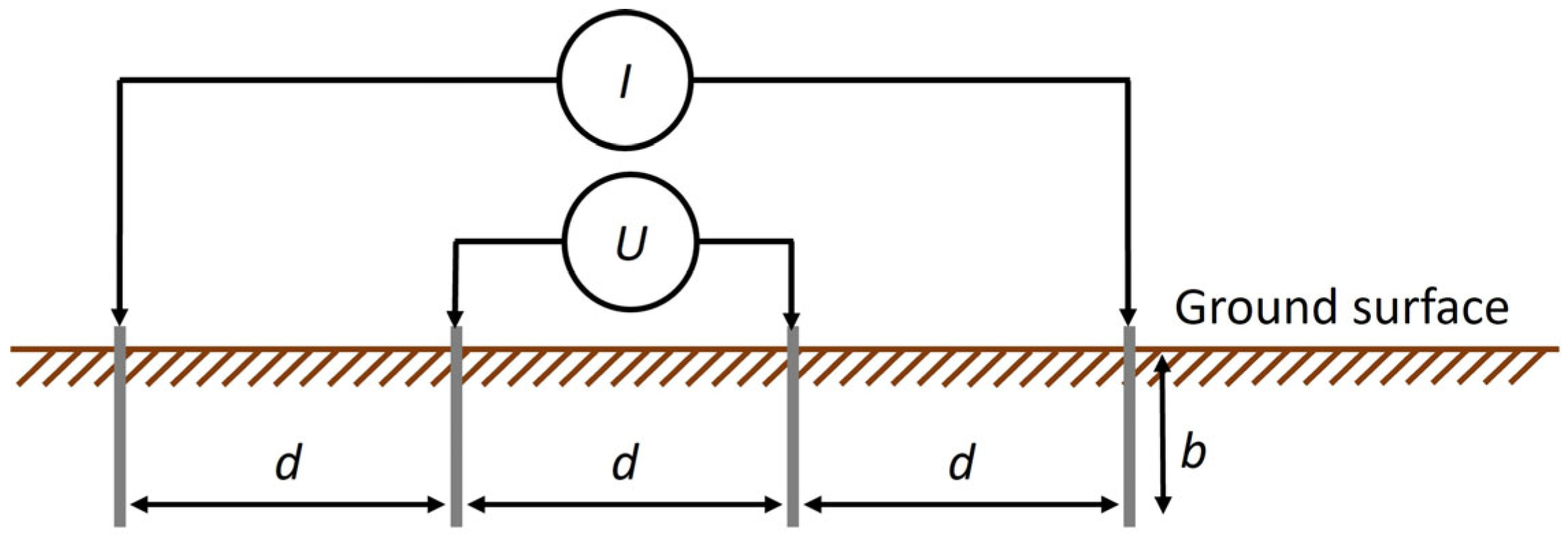
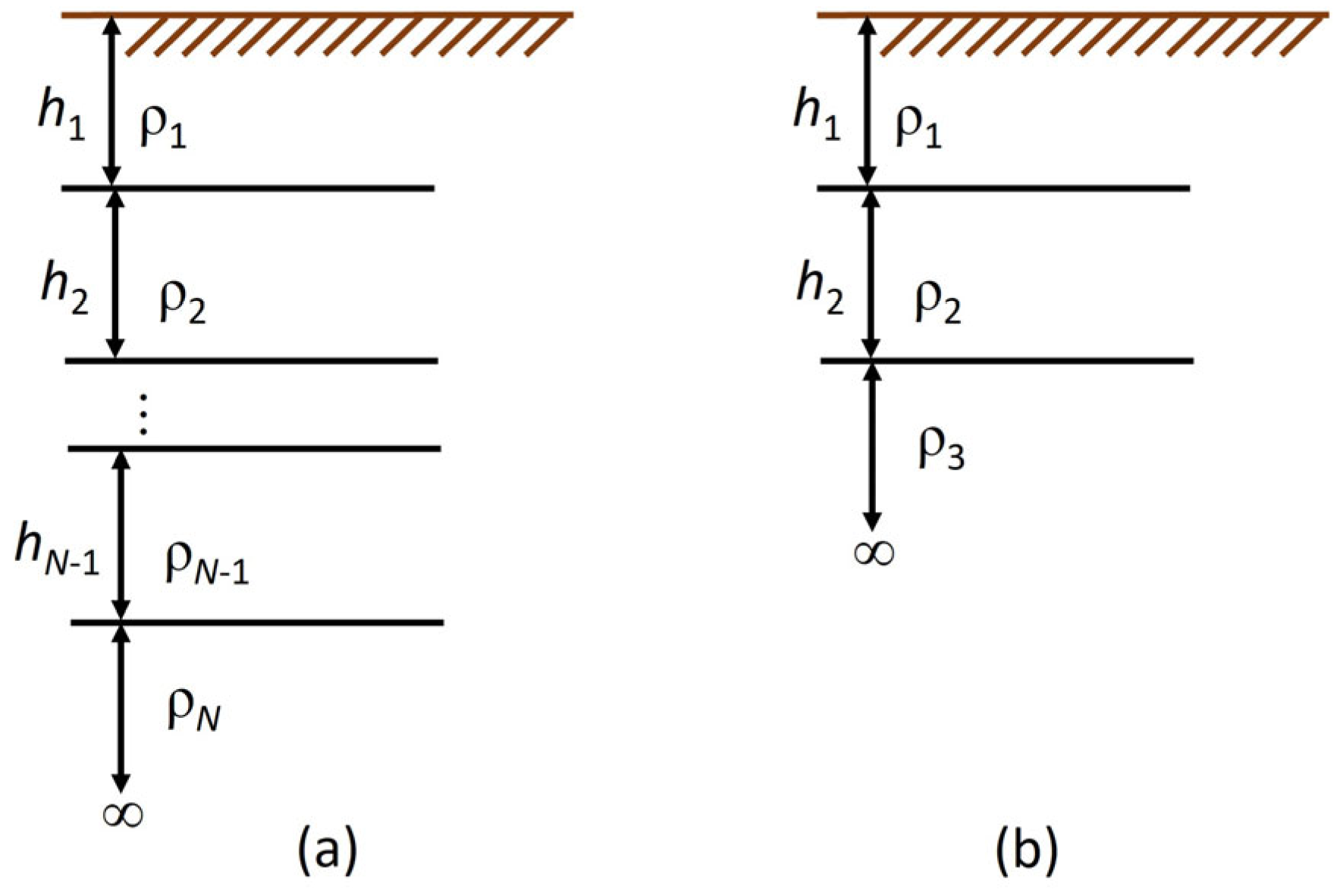

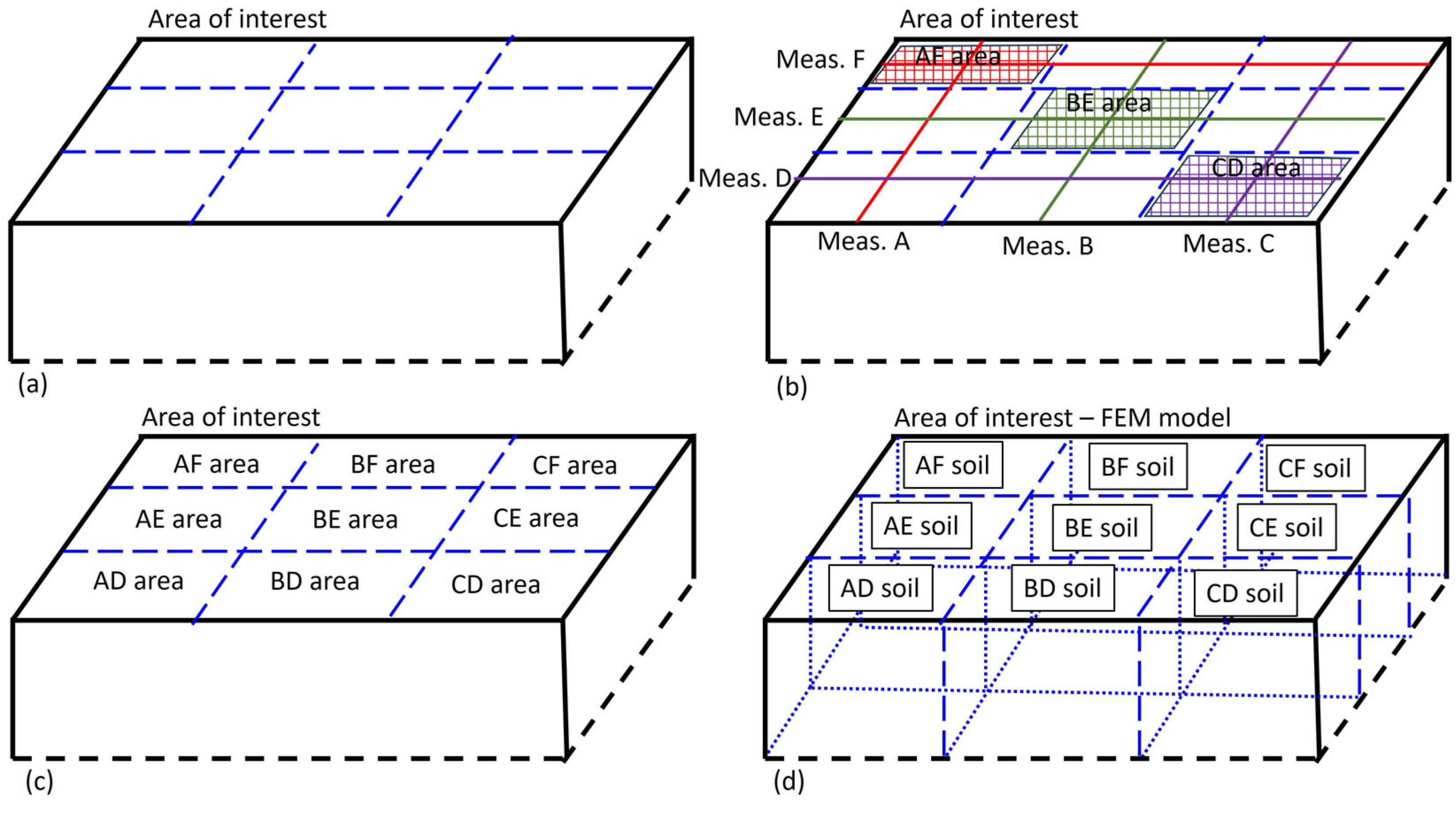
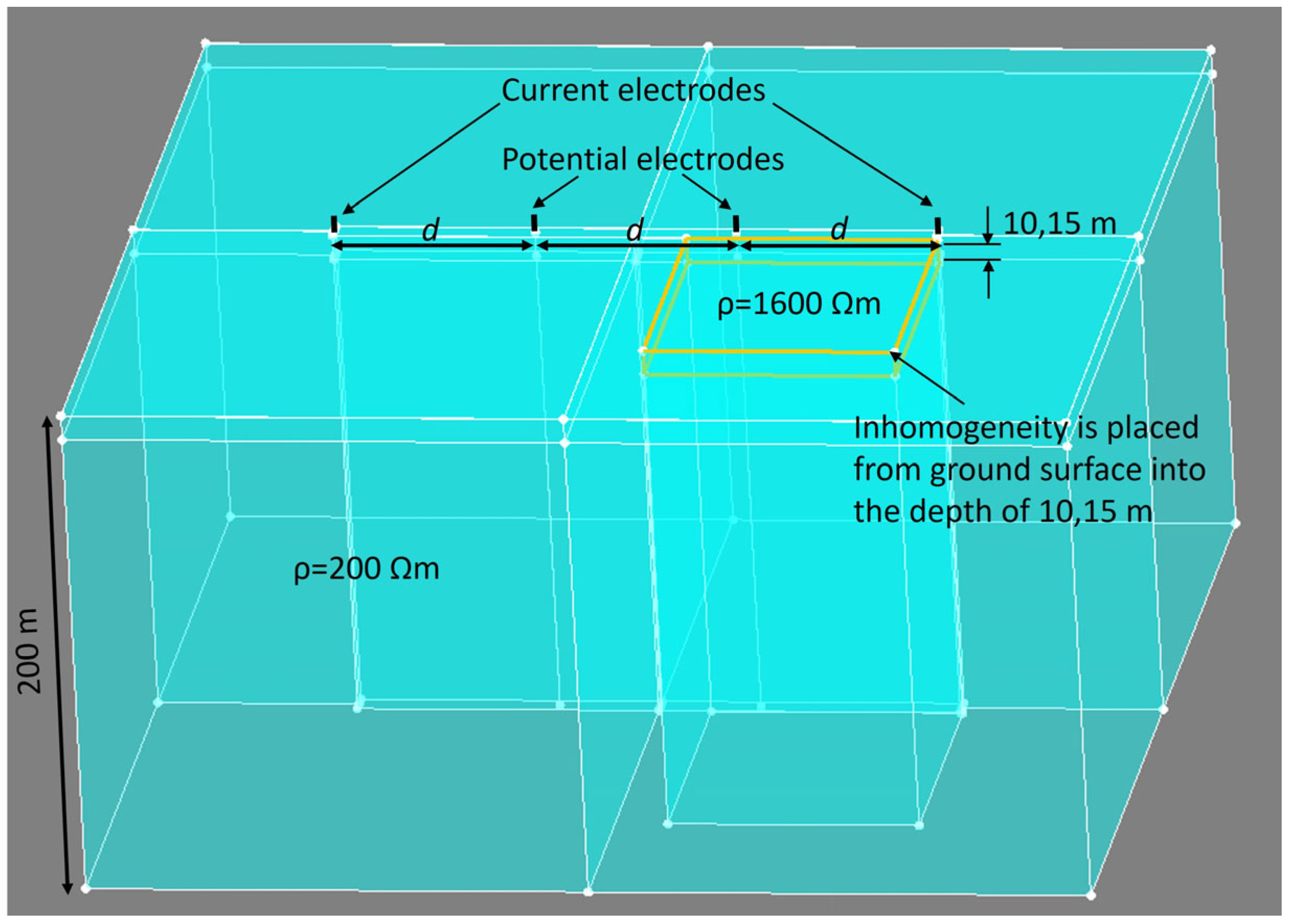
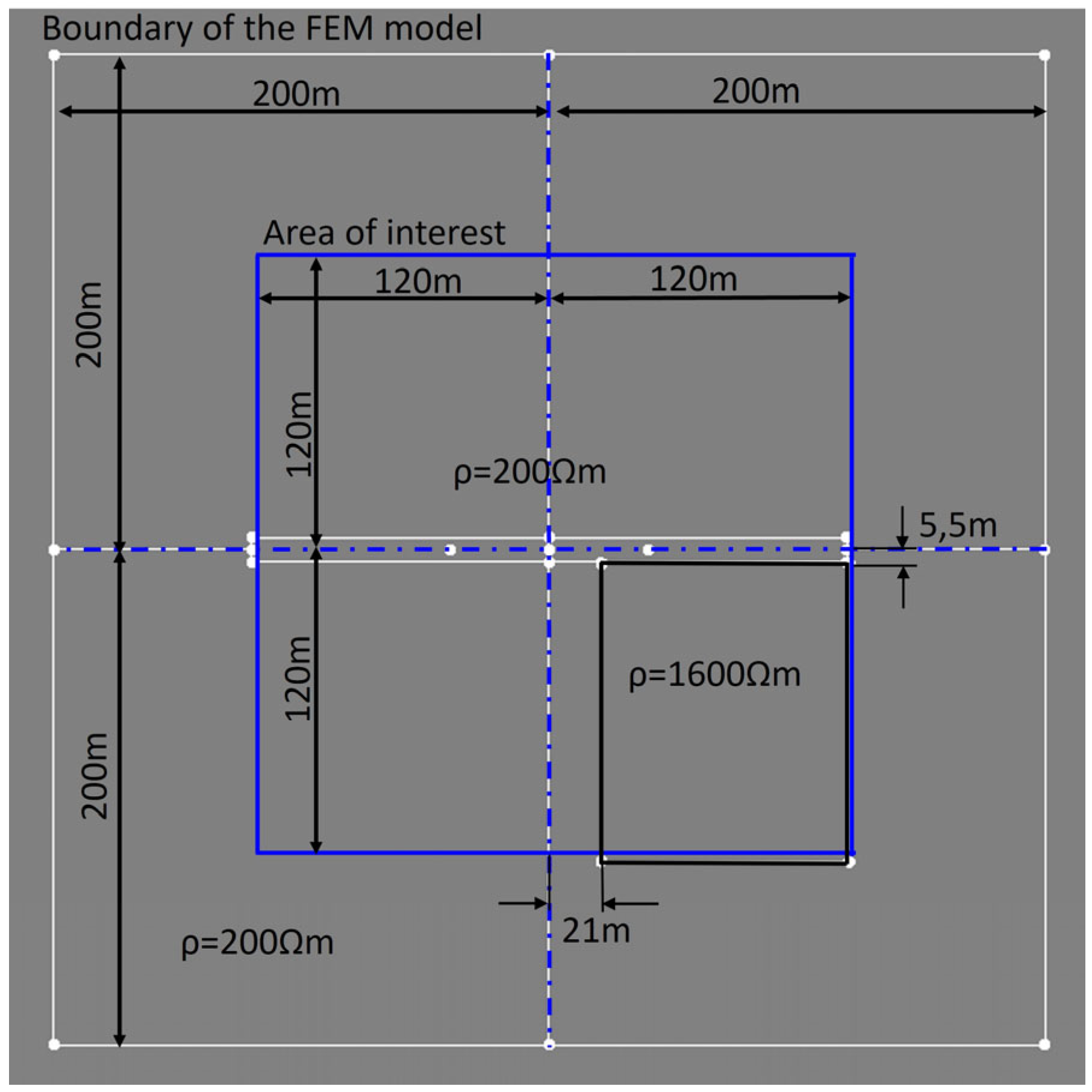
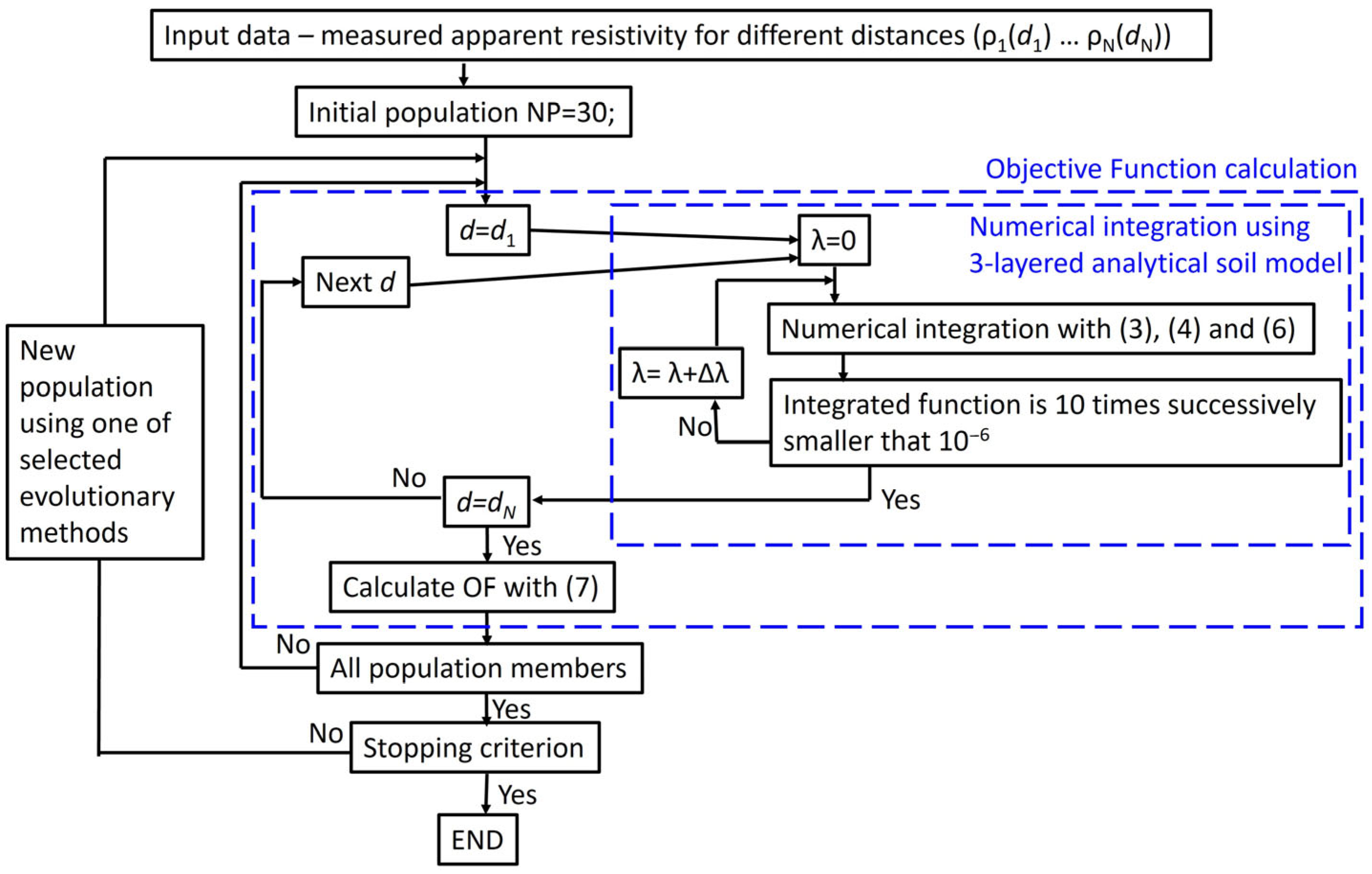

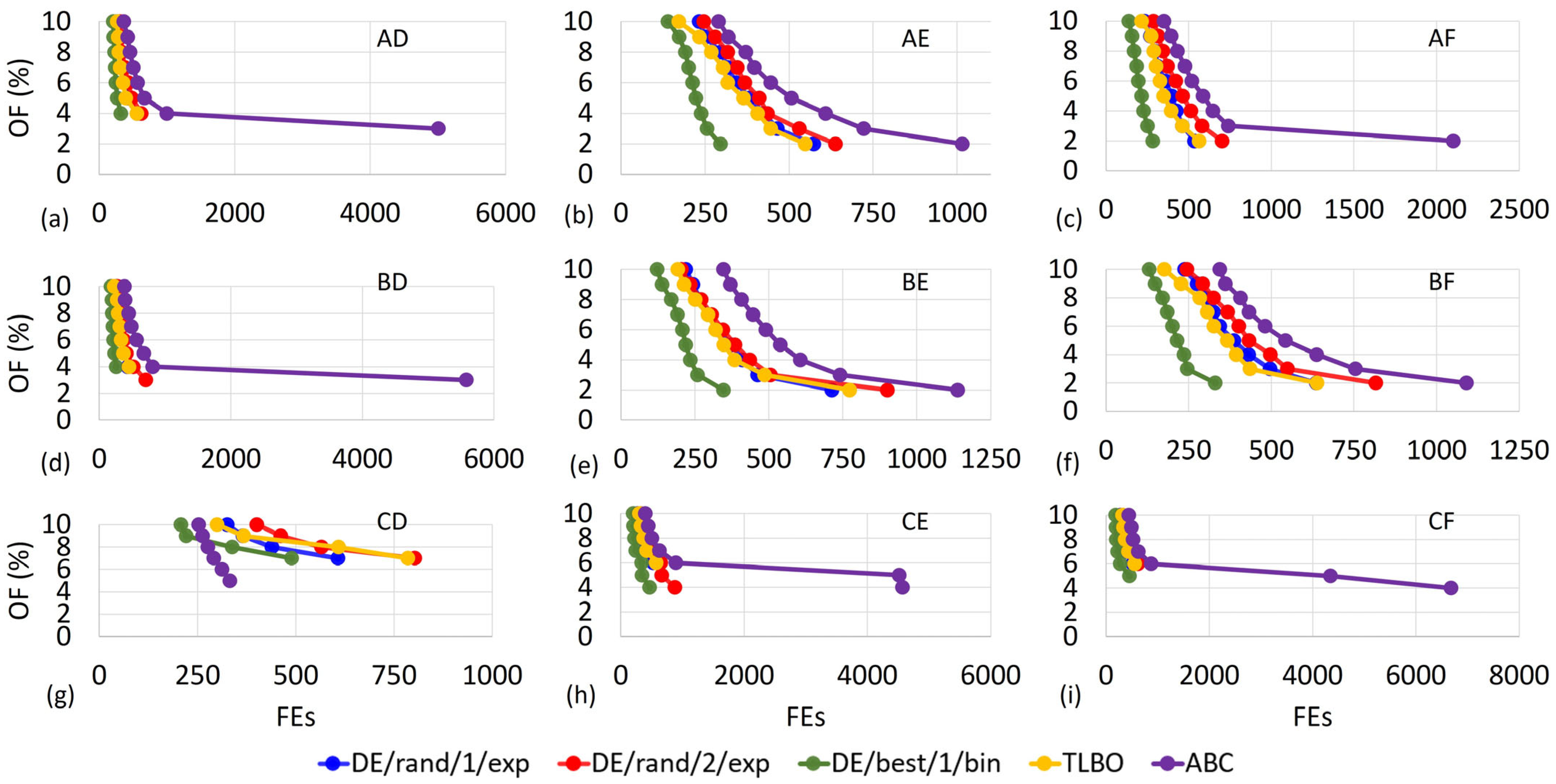
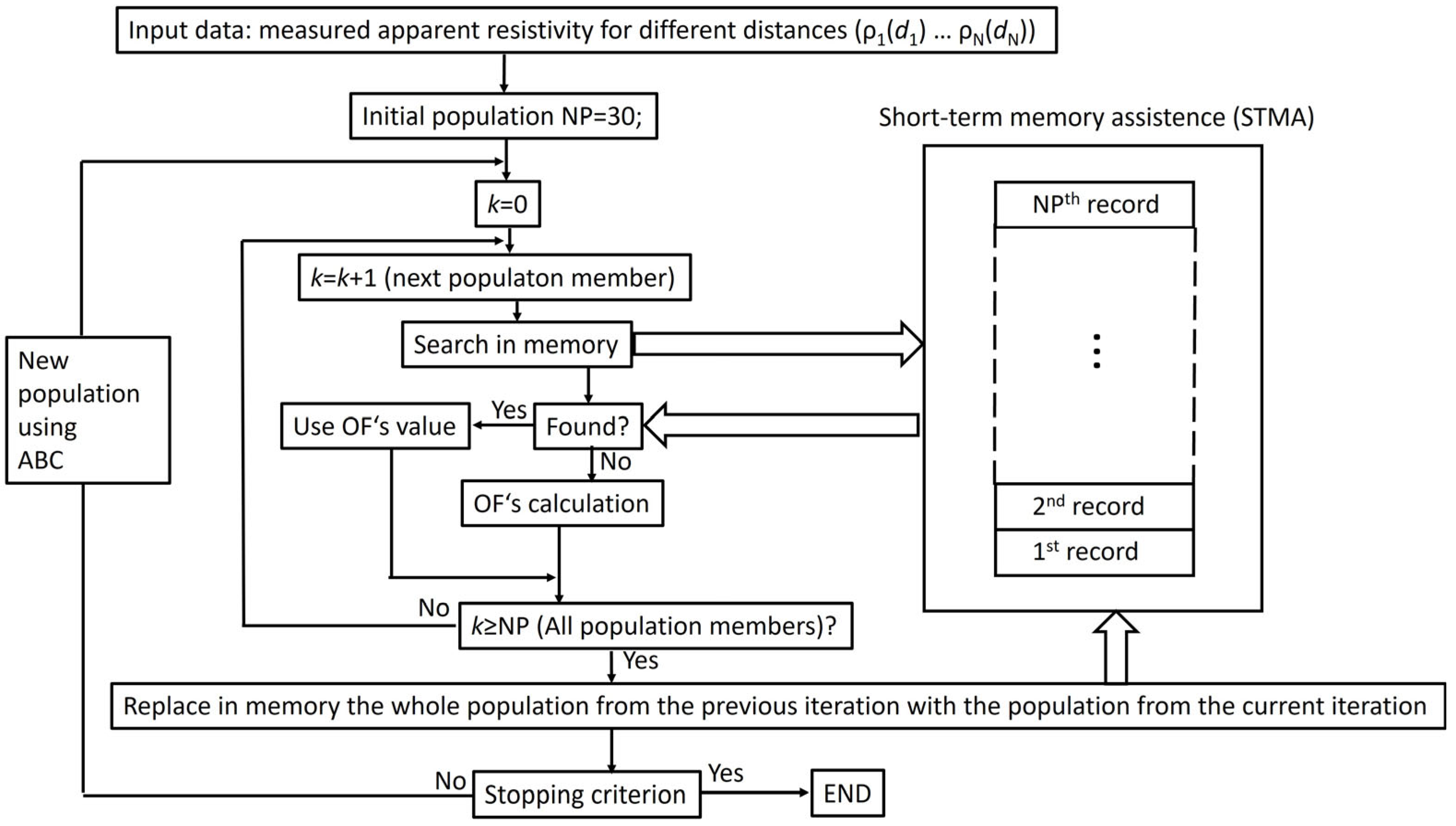
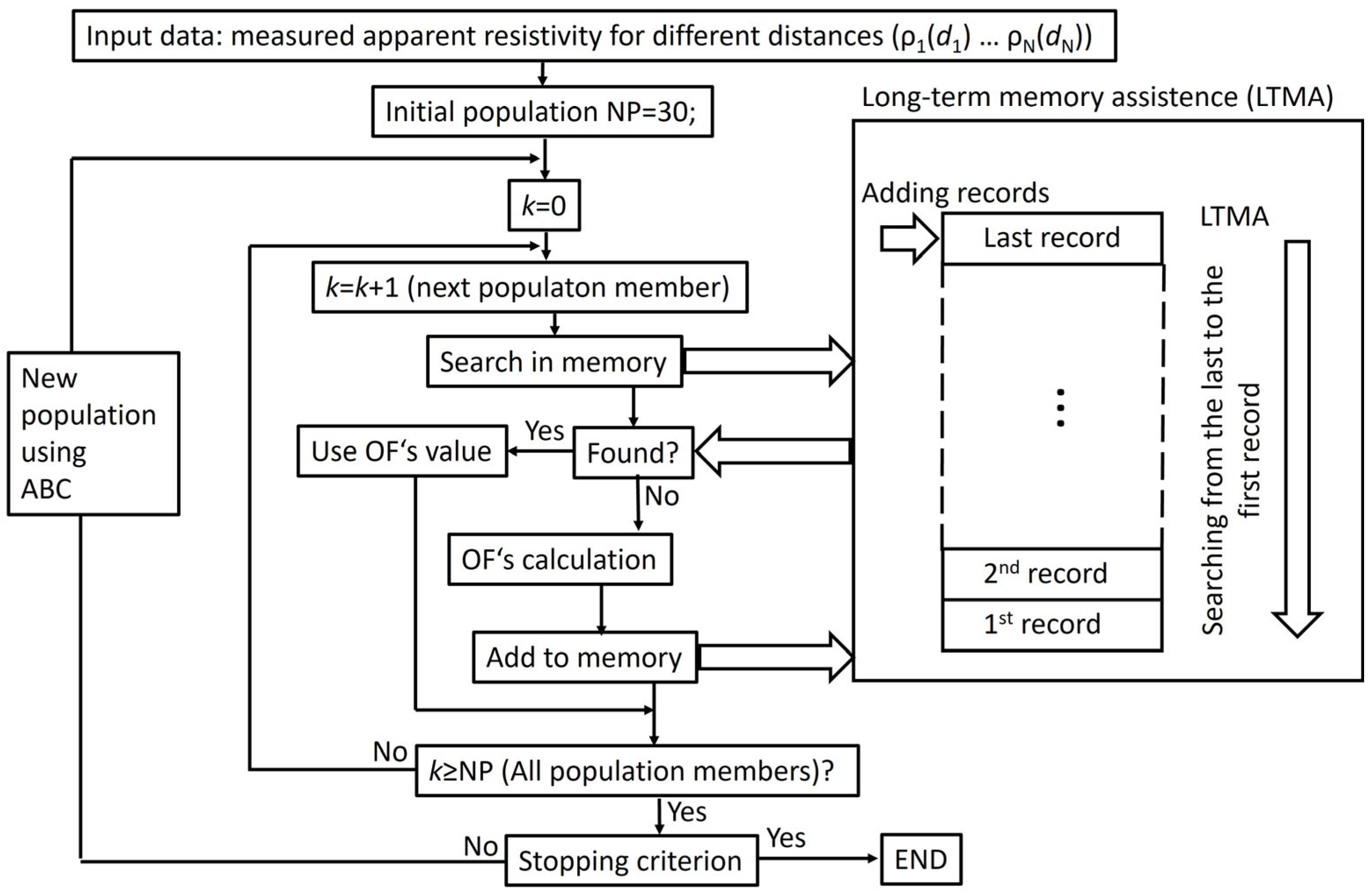
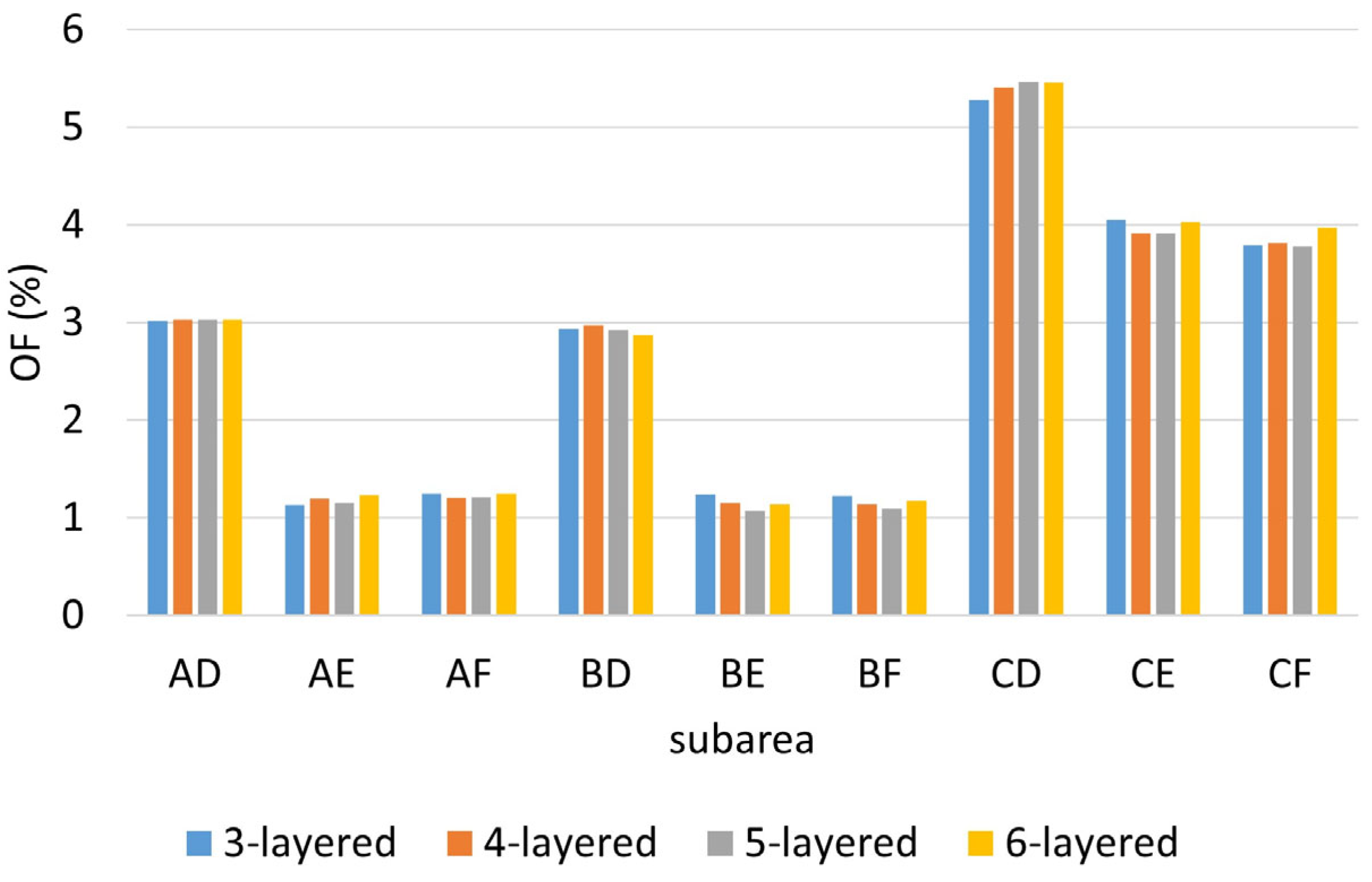
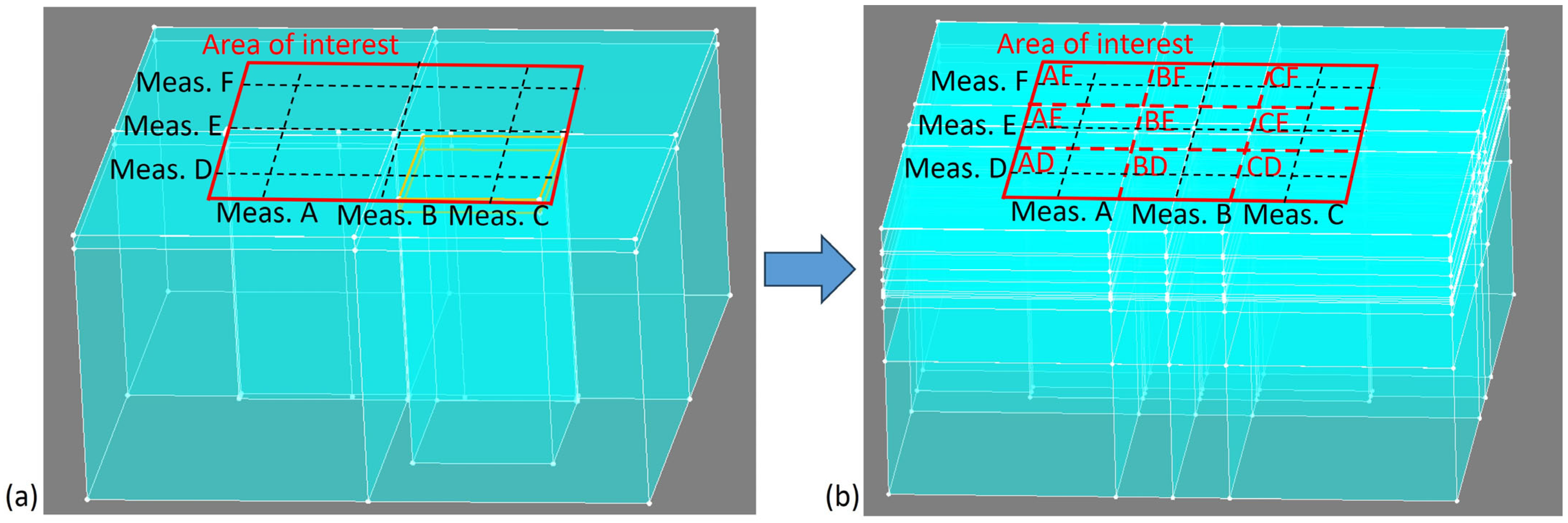
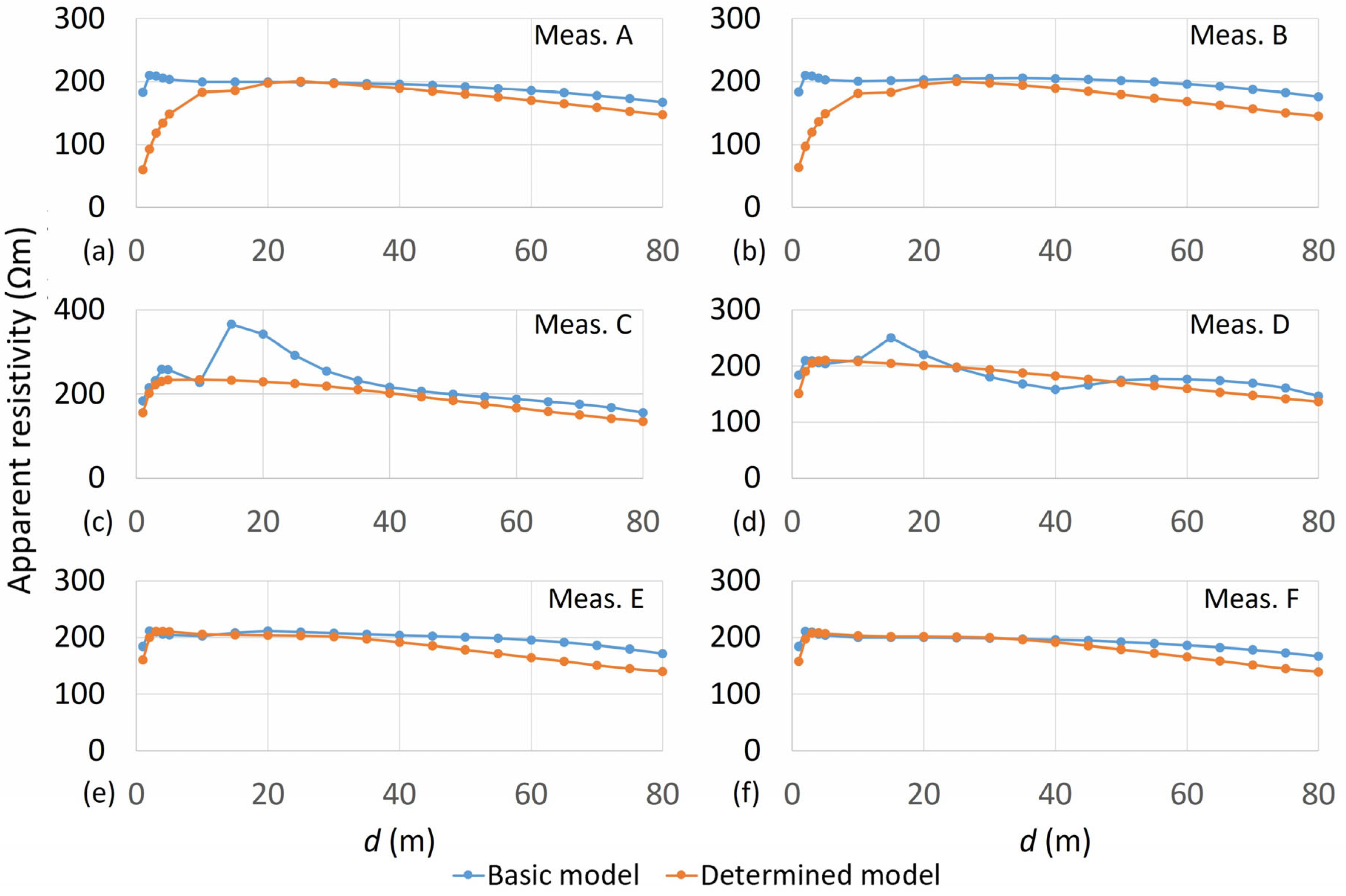

| Parameter | Lower Limit | Upper Limit |
|---|---|---|
| Resistance of the first soil layer ρ1 (Ωm) | 3 | 3500 |
| Thickness of the first soil layer h1 (m) | 0.1 | 60 |
| Resistance of the second soil layer ρ2 (Ωm) | 3 | 3500 |
| Thickness of the first soil layer h2 (m) | 0.1 | 60 |
| Resistance of the third soil layer ρ3 (Ωm) | 3 | 3500 |
| Method | Soil Model | Number of Parameters (P) | Population Number (NP) | Number of Iterations | Objective Function Evaluations |
|---|---|---|---|---|---|
| DE/rand/1/exp, DE/rand/2/exp, DE/best/1/bin | Three-layered | P 5 | NP = 6 × P 30 | ITER 600 | OFEs = NP × ITER 18,000 |
| TLBO | Three-layered | P 5 | NP = 6 × P 30 | ITER 300 | OFEs = NP × 2 × ITER 18,000 |
| ABC | Three-layered | 5 | NP = 6 × P 30 | ITER ≤600 | OFEs = NP × ITER + scouts Max. 18,000 |
| d (m) | Line A ρ (Ωm) | Line B ρ (Ωm) | Line C ρ (Ωm) | Line D ρ (Ωm) | Line E ρ (Ωm) | Line F ρ (Ωm) |
|---|---|---|---|---|---|---|
| 1 | 183.22 | 183.55 | 184.13 | 183.72 | 184.22 | 183.97 |
| 2 | 210.06 | 209.85 | 215.69 | 210.29 | 211.15 | 210.85 |
| 3 | 208.67 | 208.75 | 232.01 | 209.06 | 209.62 | 209.27 |
| 4 | 205.59 | 205.72 | 258.97 | 206.05 | 205.88 | 205.68 |
| 5 | 203.32 | 203.09 | 257.80 | 203.86 | 204.15 | 203.55 |
| 10 | 199.53 | 200.65 | 227.38 | 210.76 | 202.30 | 199.95 |
| 15 | 199.32 | 201.59 | 366.08 | 249.97 | 207.96 | 199.82 |
| 20 | 199.25 | 203.11 | 342.29 | 220.49 | 211.24 | 199.71 |
| 25 | 198.70 | 204.64 | 292.28 | 196.82 | 209.60 | 199.34 |
| 30 | 198.13 | 205.35 | 255.03 | 180.20 | 207.68 | 198.37 |
| 35 | 197.13 | 205.68 | 231.60 | 168.14 | 205.57 | 197.39 |
| 40 | 195.79 | 204.92 | 216.43 | 158.44 | 203.47 | 196.03 |
| 45 | 191.95 | 203.68 | 206.72 | 165.72 | 202.14 | 194.33 |
| 50 | 194.04 | 201.78 | 199.47 | 174.25 | 200.22 | 192.11 |
| 55 | 189.15 | 199.29 | 193.47 | 176.86 | 198.49 | 189.30 |
| 60 | 186.08 | 196.08 | 187.89 | 176.48 | 195.08 | 186.32 |
| 65 | 182.25 | 192.31 | 182.19 | 173.90 | 191.16 | 182.49 |
| 70 | 177.93 | 187.65 | 175.79 | 169.26 | 186.10 | 178.19 |
| 75 | 172.78 | 182.120 | 167.63 | 160.95 | 179.60 | 173.16 |
| 80 | 166.92 | 175.71 | 155.97 | 146.07 | 171.77 | 167.25 |
| d (m) | Area AD ρ (Ωm) | Area AE ρ (Ωm) | Area AF ρ (Ωm) | Area BD ρ (Ωm) | Area BE ρ (Ωm) | Area BF ρ (Ωm) | Area CD ρ (Ωm) | Area CE ρ (Ωm) | Area CF ρ (Ωm) |
|---|---|---|---|---|---|---|---|---|---|
| 1 | 183.47 | 183.72 | 183.60 | 183.64 | 183.88 | 183.76 | 183.93 | 184.17 | 184.05 |
| 2 | 210.17 | 210.61 | 210.45 | 210.07 | 210.50 | 210.35 | 212.99 | 213.32 | 213.27 |
| 3 | 208.86 | 209.14 | 208.97 | 208.90 | 209.18 | 209.01 | 220.53 | 220.81 | 220.64 |
| 4 | 205.82 | 205.74 | 205.64 | 205.88 | 205.80 | 205.70 | 232.51 | 232.43 | 232.33 |
| 5 | 203.59 | 203.73 | 203.44 | 203.48 | 203.62 | 203.32 | 230.83 | 230.97 | 230.68 |
| 10 | 205.14 | 200.91 | 199.74 | 205.70 | 201.47 | 200.30 | 219.07 | 214.84 | 213.67 |
| 15 | 224.65 | 203.63 | 199.57 | 225.78 | 204.78 | 200.70 | 308.02 | 287.02 | 282.95 |
| 20 | 209.87 | 205.24 | 199.48 | 211.80 | 207.17 | 201.41 | 281.39 | 276.77 | 271.00 |
| 25 | 197.76 | 204.15 | 199.02 | 200.73 | 207.12 | 201.99 | 244.55 | 250.94 | 245.81 |
| 30 | 189.16 | 202.91 | 198.25 | 192.77 | 206.52 | 201.86 | 217.61 | 231.36 | 226.70 |
| 35 | 182.63 | 201.34 | 197.26 | 186.91 | 205.62 | 201.53 | 199.87 | 218.58 | 214.49 |
| 40 | 177.12 | 199.63 | 195.91 | 181.68 | 204.19 | 200.48 | 187.44 | 209.995 | 206.23 |
| 45 | 179.88 | 198.09 | 194.19 | 184.70 | 202.91 | 199.01 | 186.22 | 204.43 | 200.52 |
| 50 | 183.10 | 196.09 | 192.03 | 188.01 | 201.00 | 196.94 | 186.86 | 199.85 | 195.79 |
| 55 | 183.00 | 193.77 | 189.22 | 188.07 | 198.84 | 194.29 | 185.16 | 195.92 | 191.38 |
| 60 | 181.28 | 190.58 | 186.20 | 186.28 | 195.58 | 191.20 | 182.19 | 191.49 | 187.11 |
| 65 | 178.07 | 186.70 | 182.37 | 183.11 | 191.74 | 187.40 | 178.04 | 186.67 | 182.34 |
| 70 | 173.59 | 182.01 | 178.06 | 178.45 | 186.87 | 182.92 | 172.52 | 180.95 | 176.99 |
| 75 | 166.87 | 176.19 | 172.97 | 171.57 | 180.90 | 177.68 | 164.29 | 173.62 | 170.40 |
| 80 | 156.50 | 169.35 | 167.08 | 160.89 | 173.74 | 171.48 | 151.02 | 163.87 | 161.61 |
| OF and | Method | |||||
|---|---|---|---|---|---|---|
| Parameters | DE/rand/1/exp | DE/rand/2/exp | DE/best/1/bin | TLBO | ABC | |
| B | 3.0896 | 3.0896 | 3.0896 | 2.8582 | 2.8489 | |
| OF (%) | W | 3.7510 | 3.4542 | 3.8653 | 3.5035 | 3.3519 |
| M | 3.2400 | 3.1872 | 3.3834 | 3.1785 | 3.0170 | |
| SD | 2.0186 × 10−1 | 1.0763 × 10−1 | 2.5406 × 10−1 | 1.4714 × 10−1 | 1.4260 × 10−1 | |
| ρ1 (Ωm) | B | 206.54 | 206.54 | 206.54 | 59.01 | 57.51 |
| h1 (m) | B | 16.85 | 16.86 | 16.85 | 0.10 | 0.10 |
| ρ2 (Ωm) | B | 184.92 | 184.92 | 184.92 | 208.40 | 209.08 |
| h2 (m) | B | 99.82 | 99.82 | 99.82 | 21.68 | 17.14 |
| ρ3 (Ωm) | B | 5.00 | 5.00 | 5.00 | 163.14 | 167.26 |
| OF and | Method | |||||
|---|---|---|---|---|---|---|
| Parameters | DE/rand/1/exp | DE/rand/2/exp | DE/best/1/bin | TLBO | ABC | |
| B | 1.2165 | 1.2167 | 1.0296 | 1.0304 | 1.0326 | |
| OF (%) | W | 1.3779 | 1.3593 | 1.3660 | 1.3535 | 1.3074 |
| M | 1.2898 | 1.2384 | 1.3162 | 1.3024 | 1.1256 | |
| SD | 6.0563 × 10−2 | 4.7049 × 10−2 | 7.4706 × 10−2 | 6.1949 × 10−2 | 8.1256 × 10−2 | |
| ρ1 (Ωm) | B | 203.73 | 203.73 | 61.82 | 61.81 | 84.33 |
| h1 (m) | B | 55.93 | 54.54 | 0.10 | 0.10 | 0.14 |
| ρ2 (Ωm) | B | 3457.34 | 655.78 | 205.77 | 205.77 | 205.82 |
| h2 (m) | B | 2.50 | 13.60 | 100.00 | 100.00 | 100.00 |
| OF and | Method | |||||
|---|---|---|---|---|---|---|
| Parameters | DE/rand/1/exp | DE/rand/2/exp | DE/best/1/bin | TLBO | ABC | |
| B | 1.2560 | 1.1947 | 1.1947 | 1.2560 | 1.1974 | |
| OF (%) | W | 1.4450 | 1.4408 | 1.4332 | 1.4211 | 1.3651 |
| M | 1.3788 | 1.2972 | 1.3826 | 1.3769 | 1.2462 | |
| SD | 6.6917 × 10−2 | 7.2750 × 10−2 | 6.7640 × 10−2 | 5.6695 × 10−2 | 4.0584 × 10−2 | |
| ρ1 (Ωm) | B | 199.77 | 67.62 | 67.62 | 199.77 | 67.76 |
| h1 (m) | B | 60.17 | 0.10 | 0.10 | 60.17 | 0.10 |
| ρ2 (Ωm) | B | 2940.90 | 201.76 | 201.76 | 3494.85 | 201.86 |
| h2 (m) | B | 2.76 | 100.00 | 100.00 | 2.32 | 100.00 |
| ρ3 (Ωm) | B | 5.00 | 23.21 | 23.21 | 5.00 | 22.84 |
| OF and | Method | |||||
|---|---|---|---|---|---|---|
| Parameters | DE/rand/1/exp | DE/rand/2/exp | DE/best/1/bin | TLBO | ABC | |
| B | 3.0402 | 2.8071 | 2.8071 | 3.0402 | 2.8106 | |
| OF (%) | W | 3.3473 | 3.3472 | 3.3474 | 3.3474 | 3.1828 |
| M | 3.2035 | 3.2148 | 3.2698 | 3.2673 | 2.9380 | |
| SD | 1.4430 × 10−1 | 1.5686 × 10−1 | 1.3305 × 10−1 | 1.1933 × 10−1 | 9.7723 × 10−2 | |
| ρ1 (Ωm) | B | 206.62 | 58.33 | 58.33 | 206.61 | 58.55 |
| h1 (m) | B | 17.03 | 0.10 | 0.10 | 17.09 | 0.10 |
| ρ2 (Ωm) | B | 192.41 | 208.53 | 208.53 | 192.37 | 208.57 |
| h2 (m) | B | 97.27 | 18.69 | 18.69 | 97.24 | 19.24 |
| ρ3 (Ωm) | B | 5.00 | 171.81 | 171.81 | 5.00 | 171.38 |
| OF and | Method | |||||
|---|---|---|---|---|---|---|
| Parameters | DE/rand/1/exp | DE/rand/2/exp | DE/best/1/bin | TLBO | ABC | |
| B | 1.1966 | 1.1969 | 1.1966 | 1.1967 | 1.1973 | |
| OF (%) | W | 1.7280 | 1.6738 | 1.7409 | 1.6744 | 1.4790 |
| M | 1.2570 | 1.2166 | 1.5157 | 1.3912 | 1.2340 | |
| SD | 1.6158 × 10−1 | 9.3316 × 10−2 | 2.3814 × 10−1 | 2.2395 × 10−1 | 4.5144 × 10−2 | |
| ρ1 (Ωm) | B | 204.30 | 204.42 | 204.30 | 204.30 | 204.42 |
| h1 (m) | B | 48.62 | 48.26 | 48.62 | 48.63 | 48.81 |
| ρ2 (Ωm) | B | 3347.50 | 1124.28 | 3495.95 | 3499.37 | 3353.95 |
| h2 (m) | B | 3.01 | 9.03 | 2.88 | 2.88 | 3.00 |
| ρ3 (Ωm) | B | 5.00 | 5.00 | 5.00 | 5.00 | 5.00 |
| OF and | Method | |||||
|---|---|---|---|---|---|---|
| Parameters | DE/rand/1/exp | DE/rand/2/exp | DE/best/1/bin | TLBO | ABC | |
| B | 1.1544 | 1.1544 | 1.1544 | 1.1544 | 1.1658 | |
| OF (%) | W | 1.6153 | 1.5850 | 3.8752 | 1.5699 | 1.4157 |
| M | 1.1997 | 1.1797 | 1.5044 | 1.4256 | 1.2230 | |
| SD | 1.3042 × 10−1 | 9.7386 × 10−2 | 3.8659 × 10−1 | 1.7582 × 10−1 | 5.1185 × 10−2 | |
| ρ1 (Ωm) | B | 201.39 | 201.44 | 201.38 | 201.39 | 201.70 |
| h1 (m) | B | 52.29 | 52.33 | 52.29 | 52.30 | 52.52 |
| ρ2 (Ωm) | B | 3473.14 | 2659.33 | 3500.00 | 3499.54 | 1011.04 |
| h2 (m) | B | 2.74 | 3.57 | 2.71 | 2.71 | 9.30 |
| ρ3 (Ωm) | B | 5.00 | 5.00 | 5.00 | 5.00 | 6.64 |
| OF and | Method | |||||
|---|---|---|---|---|---|---|
| Parameters | DE/rand/1/exp | DE/rand/2/exp | DE/best/1/bin | TLBO | ABC | |
| B | 6.4248 | 6.4248 | 4.9210 | 6.4250 | 4.9306 | |
| OF (%) | W | 6.7675 | 6.5447 | 8.4954 | 6.6956 | 6.1153 |
| M | 6.5136 | 6.5094 | 6.6039 | 6.5218 | 5.2753 | |
| SD | 5.4329 × 10−2 | 4.6391 × 10−2 | 4.6255 × 10−1 | 3.9922 × 10−2 | 2.9209 × 10−1 | |
| ρ1 (Ωm) | B | 220.56 | 220.56 | 40.99 | 220.56 | 78.72 |
| h1 (m) | B | 24.22 | 24.22 | 0.10 | 24.31 | 0.20 |
| ρ2 (Ωm) | B | 187.95 | 187.96 | 235.73 | 187.76 | 235.96 |
| h2 (m) | B | 76.60 | 76.60 | 35.63 | 17.62 | 30.35 |
| ρ3 (Ωm) | B | 5.00 | 5.00 | 122.64 | 5.02 | 134.77 |
| OF and | Method | |||||
|---|---|---|---|---|---|---|
| Parameters | DE/rand/1/exp | DE/rand/2/exp | DE/best/1/bin | TLBO | ABC | |
| B | 5.3682 | 3.9605 | 3.5159 | 4.5717 | 3.5846 | |
| OF (%) | W | 5.3735 | 5.3735 | 6.4205 | 5.3700 | 5.3712 |
| M | 5.3692 | 5.3410 | 5.3106 | 5.3532 | 4.0532 | |
| SD | 6.5976 × 10−4 | 1.9721 × 10−1 | 4.6429 × 10−1 | 1.1165 × 10−1 | 4.1656 × 10−1 | |
| ρ1 (Ωm) | B | 220.82 | 42.52 | 135.81 | 213.61 | 41.59 |
| h1 (m) | B | 83.57 | 0.10 | 0.45 | 5.58 | 0.10 |
| ρ2 (Ωm) | B | 31.52 | 232.40 | 238.61 | 266.98 | 235.19 |
| h2 (m) | B | 47.32 | 80.00 | 43.73 | 22.54 | 46.70 |
| ρ3 (Ωm) | B | 5.00 | 5.00 | 113.84 | 146.29 | 109.72 |
| OF and | Method | |||||
|---|---|---|---|---|---|---|
| Parameters | DE/rand/1/exp | DE/rand/2/exp | DE/best/1/bin | TLBO | ABC | |
| B | 5.1305 | 5.1306 | 3.3073 | 4.1409 | 3.3198 | |
| OF (%) | W | 5.2162 | 5.1440 | 6.6967 | 5.2162 | 5.1539 |
| M | 5.1434 | 5.1415 | 5.0912 | 5.1183 | 3.7941 | |
| SD | 1.0909 × 10−2 | 3.91066 × 10−3 | 4.2136 × 10−1 | 1.5246 × 10−1 | 4.0815 × 10−1 | |
| ρ1 (Ωm) | B | 220.65 | 220.66 | 120.04 | 45.60 | 122.10 |
| h1 (m) | B | 46.37 | 46.61 | 0.36 | 0.10 | 0.37 |
| ρ2 (Ωm) | B | 160.29 | 159.27 | 236.32 | 229.55 | 236.72 |
| h2 (m) | B | 64.99 | 65.23 | 40.03 | 79.58 | 38.78 |
| ρ3 (Ωm) | B | 5.00 | 5.00 | 120.03 | 5.46 | 123.51 |
| Calculation | Method | ||||
|---|---|---|---|---|---|
| Times/Subarea | DE/rand/1/exp | DE/rand/2/exp | DE/best/1/bin | TLBO | ABC |
| t (s)/AD | 4.22 | 4.88 | 16.67 | 7.25 | 33.25 |
| t (s)/AE | 4.83 | 5.34 | 17.90 | 5.45 | 39.12 |
| t (s)/AF | 14.60 | 14.95 | 14.27 | 4.01 | 41.07 |
| t (s)/BD | 5.11 | 15.20 | 30.87 | 5.79 | 35.66 |
| t (s)/BE | 5.18 | 5.96 | 11.22 | 9.20 | 33.40 |
| t (s)/BF | 4.50 | 5.05 | 29.05 | 3.73 | 36.35 |
| t (s)/CD | 4.31 | 5.86 | 15.92 | 3.80 | 32.99 |
| t (s)/CE | 5.00 | 13.84 | 26.81 | 5.19 | 31.43 |
| t (s)/CF | 4.70 | 5.32 | 35.77 | 6.00 | 34.34 |
| Parameter | Maximum Difference |
|---|---|
| ρ1, ρ2, ρ3 | 0.1 mΩm |
| h1, h2 | 0.1 mm |
| Subarea | ABC t(s) | ABC + STMA t(s) | Deviation of t Using STMA (%) | Duplications STMA | ABC + LTMA t(s) | Deviation of t Using LTMA (%) | Duplications LTMA |
|---|---|---|---|---|---|---|---|
| AD | 33.25 | 28.01 | 84.2 | 1557 | 30.39 | 91.4 | 2655 |
| AE | 39.12 | 27.33 | 69.9 | 1707 | 25.92 | 66.3 | 2551 |
| AF | 41.07 | 28.77 | 70.1 | 1641 | 29.80 | 72.6 | 2615 |
| BD | 35.66 | 31.18 | 87.4 | 1670 | 30.68 | 86.0 | 2738 |
| BE | 33.40 | 26.84 | 80.4 | 1677 | 25.93 | 77.6 | 2484 |
| BF | 36.35 | 28.74 | 79.1 | 1549 | 26.82 | 73.8 | 2454 |
| CD | 32.99 | 27.55 | 83.5 | 1930 | 29.31 | 88.8 | 2852 |
| CE | 31.43 | 28.33 | 90.1 | 1736 | 27.36 | 87.1 | 2650 |
| CF | 34.34 | 23.13 | 67.4 | 1675 | 23.33 | 67.9 | 2784 |
| Mean | 35.29 | 27.76 | 79.1% | 1682 | 27.73 | 79.0% | 2643 |
| Subarea | Soil Model | ||||
|---|---|---|---|---|---|
| Three Layers | Four Layers | Five Layers | Six Layers | ||
| B | 2.8489 | 2.8021 | 2.6606 | 2.3731 | |
| AD | W | 3.3519 | 3.2576 | 3.2597 | 3.4385 |
| M | 3.0170 | 3.0324 | 3.0298 | 3.0313 | |
| SD | 1.4260 × 10−1 | 1.0472 × 10−1 | 1.1070 × 10−1 | 1.8770 × 10−1 | |
| B | 1.0326 | 1.0229 | 0.9435 | 0.7258 | |
| AE | W | 1.3074 | 1.3441 | 1.3186 | 1.4264 |
| M | 1.1256 | 1.1919 | 1.1502 | 1.2290 | |
| SD | 8.1256 × 10−2 | 7.3115 × 10−2 | 1.0621 × 10−1 | 1.2140 × 10−1 | |
| B | 1.1974 | 1.0378 | 0.8037 | 0.8057 | |
| AF | W | 1.3651 | 1.3703 | 1.4633 | 1.5694 |
| M | 1.2462 | 1.1984 | 1.2058 | 1.2461 | |
| SD | 4.0584 × 10−2 | 8.2700 × 10−2 | 1.1100 × 10−1 | 1.6308 × 10−1 | |
| B | 2.8106 | 2.7237 | 2.5355 | 2.4723 | |
| BD | W | 3.1828 | 3.2663 | 3.2140 | 3.2300 |
| M | 2.9380 | 2.9697 | 2.9199 | 2.8683 | |
| SD | 9.7723 × 10−2 | 9.6893 × 10−2 | 1.6189 × 10−1 | 1.8302 × 10−1 | |
| B | 1.1973 | 0.9274 | 0.8895 | 0.8382 | |
| BE | W | 1.4790 | 1.2444 | 1.2860 | 1.3274 |
| M | 1.2340 | 1.1509 | 1.0734 | 1.1341 | |
| SD | 4.5144 × 10−2 | 9.8441 × 10−2 | 1.2563 × 10−1 | 1.2988 × 10−1 | |
| B | 1.1658 | 0.9808 | 0.63834 | 0.8348 | |
| BF | W | 1.4157 | 1.2943 | 1.2521 | 1.4245 |
| M | 1.2230 | 1.1359 | 1.0909 | 1.1736 | |
| SD | 5.1185 × 10−2 | 5.9807 × 10−2 | 1.0602 × 10−1 | 1.1372 × 10−1 | |
| B | 4.9306 | 4.5902 | 4.8376 | 4.9021 | |
| CD | W | 6.1153 | 6.4191 | 6.5768 | 6.5309 |
| M | 5.2753 | 5.4091 | 5.4652 | 5.4593 | |
| SD | 2.9209 × 10−1 | 4.2134 × 10−1 | 4.5797 × 10−1 | 4.4843 × 10−1 | |
| B | 3.5846 | 3.2722 | 3.2329 | 3.4347 | |
| CE | W | 5.3712 | 5.2403 | 4.9603 | 5.4556 |
| M | 4.0532 | 3.9115 | 3.9175 | 4.0276 | |
| SD | 4.1656 × 10−1 | 3.8760 × 10−1 | 3.1435 × 10−1 | 4.0025 × 10−1 | |
| B | 3.3198 | 2.9987 | 3.3901 | 2.7103 | |
| CF | W | 5.1539 | 5.1060 | 5.0355 | 5.2276 |
| M | 3.7941 | 3.8153 | 3.7752 | 3.9706 | |
| SD | 4.0815 × 10−1 | 4.5375 × 10−1 | 3.9664 × 10−1 | 5.4033 × 10−1 |
Disclaimer/Publisher’s Note: The statements, opinions and data contained in all publications are solely those of the individual author(s) and contributor(s) and not of MDPI and/or the editor(s). MDPI and/or the editor(s) disclaim responsibility for any injury to people or property resulting from any ideas, methods, instructions or products referred to in the content. |
© 2025 by the authors. Licensee MDPI, Basel, Switzerland. This article is an open access article distributed under the terms and conditions of the Creative Commons Attribution (CC BY) license (https://creativecommons.org/licenses/by/4.0/).
Share and Cite
Jesenik, M.; Trbušić, M. The Approach of Using a Horizontally Layered Soil Model for Inhomogeneous Soil, by Taking into Account the Deeper Layers of the Soil, and Determining the Model’s Parameters Using Evolutionary Methods. Appl. Sci. 2025, 15, 1420. https://doi.org/10.3390/app15031420
Jesenik M, Trbušić M. The Approach of Using a Horizontally Layered Soil Model for Inhomogeneous Soil, by Taking into Account the Deeper Layers of the Soil, and Determining the Model’s Parameters Using Evolutionary Methods. Applied Sciences. 2025; 15(3):1420. https://doi.org/10.3390/app15031420
Chicago/Turabian StyleJesenik, Marko, and Mislav Trbušić. 2025. "The Approach of Using a Horizontally Layered Soil Model for Inhomogeneous Soil, by Taking into Account the Deeper Layers of the Soil, and Determining the Model’s Parameters Using Evolutionary Methods" Applied Sciences 15, no. 3: 1420. https://doi.org/10.3390/app15031420
APA StyleJesenik, M., & Trbušić, M. (2025). The Approach of Using a Horizontally Layered Soil Model for Inhomogeneous Soil, by Taking into Account the Deeper Layers of the Soil, and Determining the Model’s Parameters Using Evolutionary Methods. Applied Sciences, 15(3), 1420. https://doi.org/10.3390/app15031420







